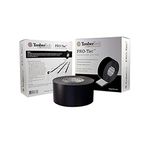Pilot Holes in a Deck Ledger
It's important to differentiate between the types of drilled holes for bolts vs. lag screws.

What diameter pilot hole do I need when fastening the deck ledger to my house, and is it the same-diameter hole if I use lag screws instead?
— Cliff, via email
Mike Guertin: First, let’s differentiate between the types of drilled holes for bolts vs. lag screws. You need to drill a clearance hole where you want a bolt or screw to pass freely through the ledger and rim joist. Lag screws are different, though. For those, you need to drill a pilot hole that accommodates the shank of the lag screw, but not one so large that the threads of the screw have no wood to bite into.
A clearance hole for a 1/2-in. bolt should be between 17/32 in. and 9/16 in., slightly larger than the bolt itself. Drilling the hole with a 1⁄2-in. bit ups the risk of the ledger board splitting. Pressure-treated lumber is often still wet from the treating process, and as
the board dries, it can crack along the bolt-hole line. Going too large is also a problem. 5/8-in. or 3/4-in. holes for 1/2-in. bolts reduce the load value of the bolt and washer through the ledger and rim.
Like through-bolts, lag screws require a clearance hole of 17/32 in. to 9/16 in. (but no greater) through the ledger board. A smaller diameter pilot hole that equals the root diameter of the threaded portion of the lag screw (usually 5/16 in.) needs to be drilled through the wall sheathing and rim joist. Properly sized pilot holes ensure that the threads of the lag screws engage with the wood for a secure connection. Undersize pilot holes—or lag screws driven through wood without a pilot hole at all—can split the rim joist and significantly reduce the strength of the screwed connection. And oversize pilot holes don’t let enough of the screw threads lock into the wood fibers and will also reduce the connection strength.
It’s worth noting that there is a third option as well. Structural screws, which are offered by many fastener companies, can be used to create a code-compliant ledger connection, and in most cases don’t require any pilot holes.
For more information on deck ledger fastenings, check out these links:
- Video: How to Install a Deck Ledger
- Deck Ledger Bolting Patterns Limit House to Deck Level Drop
- Attaching a Deck Ledger to Floor Truss
- How to Attach a Deck Ledger to the House
- Video: Fastening a Ledger to Concrete
Fine Homebuilding Recommended Products
Fine Homebuilding receives a commission for items purchased through links on this site, including Amazon Associates and other affiliate advertising programs.

Flashing and Joist Tape

N95 Respirator

FastenMaster Screw Bolt Fastening System






















